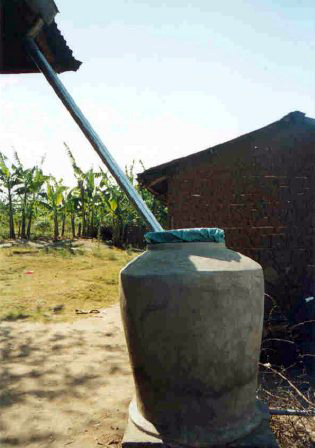What if you don’t have any clay pots?

Ideally filters are both home-made and biological. This is still possible where clay pots or other materials needed for this filter are not available, by making adaptations. For example in the place of clay pots concrete pots are used which can easily be made.
Warwick University has a simple way for people to make their own concrete pots:
Download Ferro-Cement Jar Instructions for manufacture [PDF]
In civil public health emergencies effective filters can be built in situ with bricks or broken paving slabs and cement mortar.
Below are guidelines for making adaptations without reducing the performance of the filter.
Advocates of the filter support appropriate technology that not only can be maintained locally, but can be made by the families themselves, with materials they can afford and easily get hold of, and can be replicated by other families.
By making the necessary adaptations to the materials used, more people will be able to become self sufficient at making biological filters.
This is valuable because uneducated and disempowered people are vulnerable to the tendency to become passive recipients of help from development organisations.
This tendency can be reinforced more and more by each project introduced that does not work on a self-help basis.
With a home-made filter people’s self sufficiency increases so they don’t add to or suffer from market forces.
The design is easy to replicate and it is cheap enough for people to afford themselves so it will make them feel richer and more able as they make their own filter with materials they already have access to.
It will therefore strengthen the values that help people who are vulnerable to consumerist aspects of development: valuing the responsibility to overcome our own problems; valuing what we already have; valuing knowledge we can share with others; our health.
Adaptations
As long as adaptations do not contravene the principles and instructions below that safeguard the beneficial biology and function of the filter, highly effective home-made biological filters can be made using the locally available materials.
Once filters with the adaptations have been tested, filter teacher training projects can be setup to pass on the adapted design to the local families.
Concept and principles for making adaptations, to be read with the construction instructions.
Materials used must be locally available and ideally familiar to the families who need to make biological filters.
The filter must produce the controlled and protected environment needed for sufficient beneficial biology to colonize it.
The features key to the well being of the beneficial biology and functioning of the filter are as follows:
- An even drainage provided by the layers of stones and gravel below the sand. This is so that no water takes a short cut and it all slowly passes as many beneficial microbes as possible that live on the surface of the sand grains.
- Sufficient depth of sand 12 inches. This provides enough homes for the beneficial biology.
- The inside diameter of the filter should be 10 to 14 inches. (This allows approximately 15 liters to pass through in the first 30 minutes)
- A hose with no joins or splits. This provides an outlet for the clean water and reliably prevents water from becoming re-contaminated as it rises up and out.
- The hose outlet must be 5 inches above the top of the sand.
- The beneficial microbes are aquatic so the sand must always be under water.
- The beneficial biology on the surface of the sand must not be disturbed by the water flowing in.
- 5 inches insures that the water level is maintained above the sand allowing an inch for if the filter is not make accurately, 1.5 inches for evaporation and 2.5 inches depth of water to provides a buffer zone preventing water flowing in from churning up the sand and upsetting the service beneficial biology.
- A hole in the main container at this level needs only a low pressure seal which is easy to achieve and also any leaks are slower and of less significance.
- A poor seal here does not threaten to re-contaminate the filtered water.
- The top pot should have one small hole of the diameter of a typical 3 inch nail. This prevents water flowing into the filter too fast so the top layer of sand is not disturbed.
- The bottom of the top pot and the top of the filter pot should be 10 to 12 inches above the level the pipe exits the filter. This provides the water pressure to drive the filter.
- The top pot must be fixed in place to prevent the sand being tampered with.
- The clean water must be protected from recontamination.
- A light weight cloth over the top pot acts as a screen to prevent leaves blocking the small hole.
- There should be a gap between the top pot and the filter to let in oxygen. This also means that the water flowing in can be seen allowing a blockage in the small hole to be notices if it occurs.
Note: You can download all of the manuals and files associated with this website on our download page